The Plextor M8Pe (512GB) SSD Review
by Billy Tallis on December 14, 2016 9:00 AM ESTRandom Read Performance
The random read test requests 4kB blocks and tests queue depths ranging from 1 to 32. The queue depth is doubled every three minutes, for a total test duration of 18 minutes. The test spans the entire drive, which is filled before the test starts. The primary score we report is an average of performances at queue depths 1, 2 and 4, as client usage typically consists mostly of low queue depth operations.
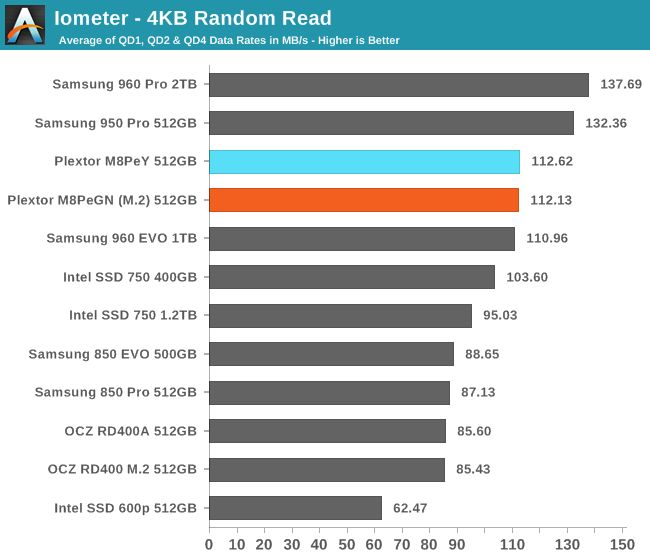
The Plextor M8Pe's random read speed cannot match Samsung's 3D MLC-based 950 Pro or 960 Pro, but it is otherwise very good. The 30% lead over the OCZ RD400 is particularly notable given that it uses the same NAND as the M8Pe.
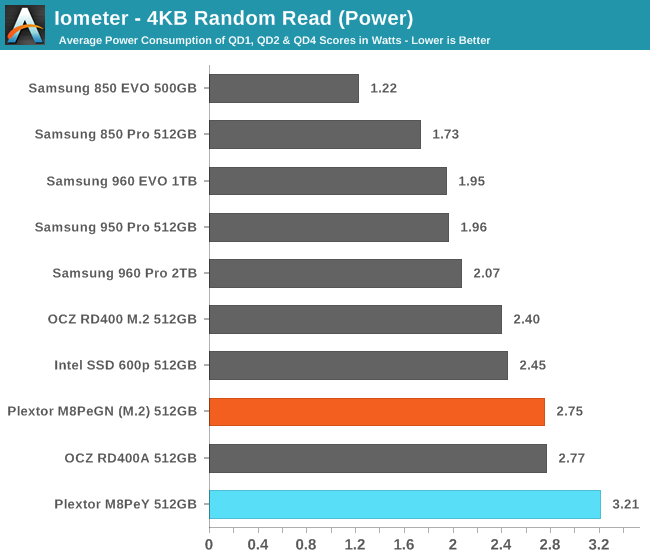
Power consumption is again higher than the rest of the M.2 PCIe SSDs, but given the good performance it does manage to be more efficient than the OCZ RD400.
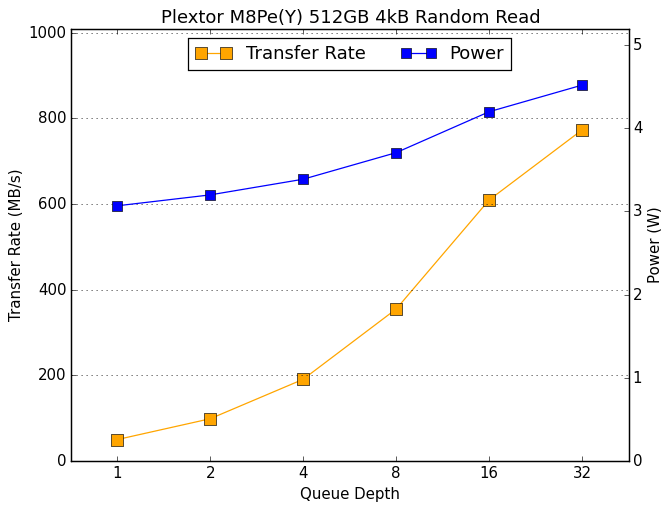 |
|||||||||
It appears that there is a little bit of thermal throttling happening on the M8PeGN in the final phase of the test at QD32, but otherwise it scales well as queue depths increase. Samsung's SSDs mostly saturate at QD16 while the M8Pe continues to scale up, albeit with diminishing returns.
Random Write Performance
The random write test writes 4kB blocks and tests queue depths ranging from 1 to 32. The queue depth is doubled every three minutes, for a total test duration of 18 minutes. The test is limited to a 16GB portion of the drive, and the drive is empty save for the 16GB test file. The primary score we report is an average of performances at queue depths 1, 2 and 4, as client usage typically consists mostly of low queue depth operations.
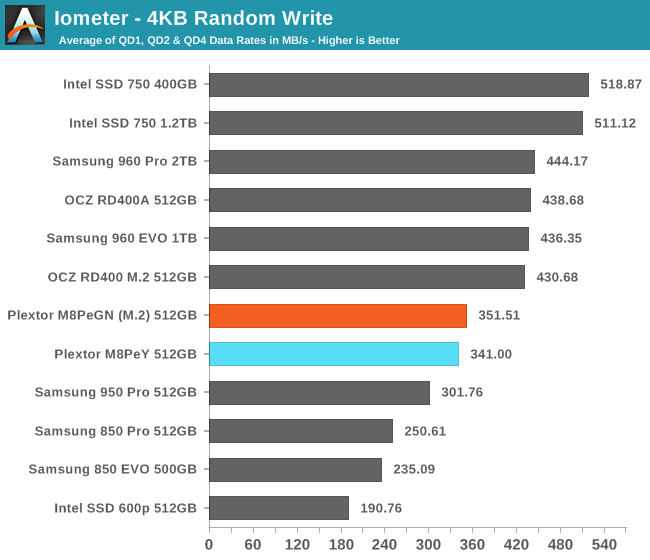
The random write performance of the Plextor M8Pe is better than the Samsung 950 Pro but falls behind more recent MLC-based PCIe SSDs, and Intel's SSD 750 is still the best.
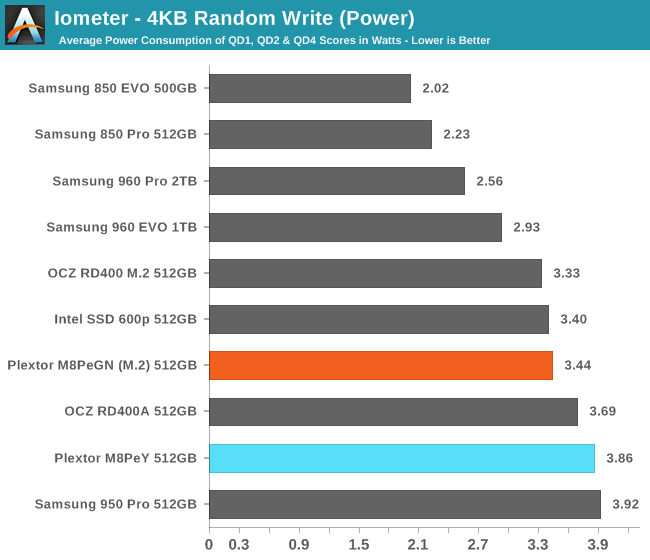
The M8Pe's power consumption is only slightly worse than the OCZ RD400, but its efficiency is still substantially worse. The Samsung 950 Pro had even higher power consumption and delivered what is now unimpressive random write performance, so the M8Pe isn't the least efficient of the MLC-based SSDs.
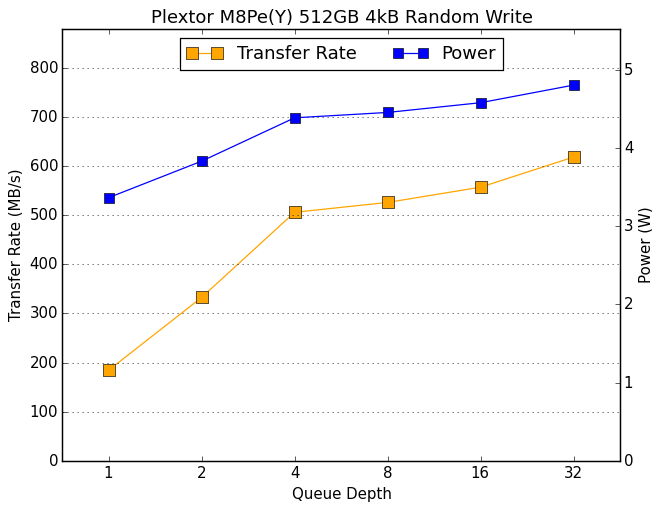 |
|||||||||
Performance increases relatively slowly for the M8PeY in the second half of the test, and actually decreases for the M8PeGN, indicating thermal throttling as power consumption hits 4 W.










64 Comments
View All Comments
MrSpadge - Wednesday, December 14, 2016 - link
Considering your ADATA is quite small at just 1 GB, these will be a noticeable upgrade. Starting from a 1 TB drive, though, will likely not be noticeable (unless you're running significantly I/O limited workloads).Ratman6161 - Wednesday, December 14, 2016 - link
Assuming you meant 1TB rather than 1 GB. Can the majority of humans tell the difference? I can't speak to what the majority can tell but I can state my personal experience. My main system drive is currently a 250 GB 850 EVO. I've also had an opportunity to (though briefly) to use a system with a 950 Pro in it. For anything that I personally do, no, I could not tell the difference. Of course I don't do anything particularly storage intensive either. I'm most concerned with boot up time and how fast programs open, etc.To me, given pricing as it exists today, there are only really three drives mentioned that I would even think about. Assuming you need an m.2 form factor (which I currently don't so will stick with my 850 EVO) 960 Pro if you want the best performance available, 960 EVO if you want great upscale performance at a reasonable price, and the Intel 600 P if you don't need great performance but do need the M.2 form factor. But if the prices change it may well be possible to just buy the cheapest in the particular performance class you want.
sinPiEqualsZero - Wednesday, December 14, 2016 - link
Thanks to both of you. I did mean 1 TB, my bad. I have one of the DAN cases and will be building it out in Jan/Feb, that's why I asked. Looks like I'm sticking with SATA unless prices come down. Mayyyyybe the 960 EVO.Bruce427 - Friday, December 16, 2016 - link
** [get] the Intel 600 P if you don't need great performance but do need the M.2 form factor. **Currently, the MyDigital BPX NVMe drives will significantly outperform the 600Ps, and for less money.
They also use MLC flash and have a full 5 year warranty.
I have several 950 Pros. I recently bought/installed a 240GB BPX for benchmarking/testing and at $107.85 (what I paid) it's a great little drive.
Death666Angel - Sunday, December 18, 2016 - link
MyDigital doesn't have European retailers it seems? At least nothing but one listing in Germany for a BP4. :/ddriver - Saturday, December 17, 2016 - link
No, 99% of the use cases won't show tangible improvement. SATA SSDs are already fast enough to eliminate storage as a bottleneck. You may have TB\sec and it will still not make a difference if the bottleneck is somewhere else.peterfares - Wednesday, December 14, 2016 - link
Why is there a power connector on top?Billy Tallis - Wednesday, December 14, 2016 - link
I think it's just an alternate power delivery path for situations where the PCIe slot doesn't provide enough. I didn't bother using it, since I was measuring power consumption through the PCIe slot.XabanakFanatik - Wednesday, December 14, 2016 - link
When are you going to redo new drives like the 960 Pro/Evo and RD400 with the angelbird wings PX1 so we can see how and if oerformance improves with a heatsink?Last year AT had redone benches from the 950 pro this way.
Billy Tallis - Wednesday, December 14, 2016 - link
At the moment, I'm more concerned with putting together an updated test suite for 2017. Once that's ready and everything's been re-tested, I'll go back and test the 960s with a heatsink. It'll probably be February, and probably won't be worth an article of its own.We already have the RD400A results in Bench, and the one thermal pad behind the controller that it uses was enough to eliminate thermal throttling (with one possible exception).